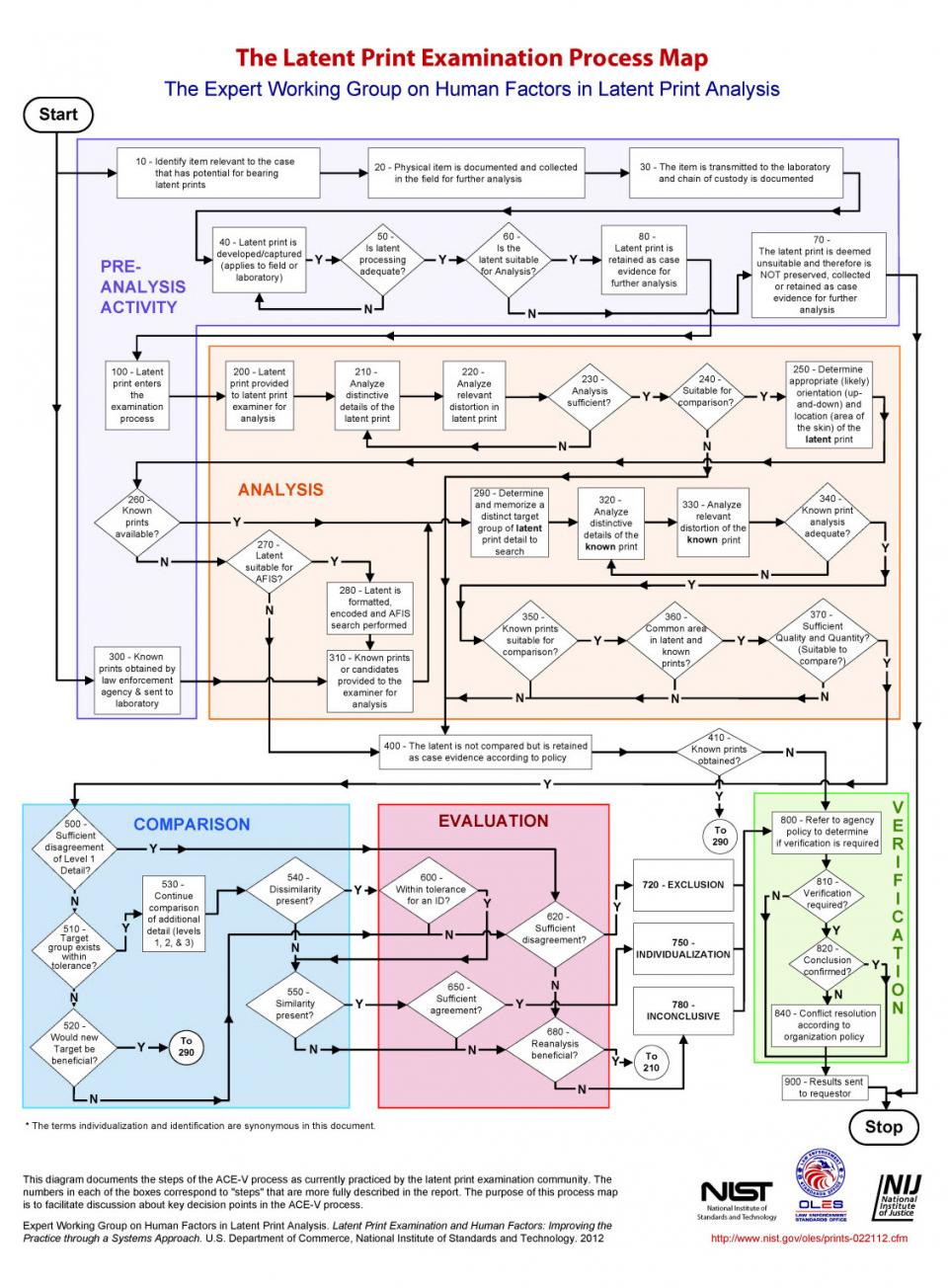Flowchart of Analysis, Comparison Evaluation and Verification of Latent Prints
The Latent Print Examination Process Map
The Expert Working Group on Human Factors in Latent Print Analysis
Note: the numbering in this process map relates to the full report. Some numbers in the sequencing are skipped.
- Start — this process can begin at step 10 or 300.
- Pre-Analysis Activity
- 10 — Identify item relevant to the case that has potential for bearing latent prints
- 20 — Physical item is documented and collected in the field for further analysis
- 30 — The item is transmitted to the laboratory and chain of custody is documented
- 40 — Latent print is developed/captured (applies to field or laboratory)
- 50 — Is latent processing adequate?
- No, to 40.
- Yes, to 60
- 60 — Is the latent suitable for Analysis?
- No, to 70
- Yes, to 80
- 70 — The latent print is deemed unsuitable and therefore is NOT preserved, collected or retained as case evidence for further analysis. To STOP
- 80 — Latent print is retained as case evidence for further analysis
- 100 — Latent print enters the examination process [this step is a Pre-Analysis Activity but is listed here for simplicity]
- Analysis
- 200 — Latent print provided to Latent Print Examiner for analysis
- 210 — Analyze distinctive details of the latent print
- 220 — Analyze relevant distortion in latent print
- 230 — Analysis sufficient?
- No, to 210
- Yes, to 240
- 240 — Suitable for comparison?
- No, to 400
- Yes, to 250
- 250 — Determine appropriate (likely) orientation (up-and-down) and location (area of the skin) of the latent print
- 260 — Known prints available? [this step is a Pre-Analyis Activity but is listed here for simplicity]
- No, to 270
- Yes, to 290
- 270 — Latent suitable for AFIS?
- No, to 400
- Yes, to 280
- 280 — Latent is formatted, encoded and AFIS Search performed (to 310)
- 290 — Determine and memorize a distinct target group of latent print detail to search (to 320)
- 300 — Known prints obtained by law enforcement agency & sent to laboratory [this step is an entry point in the process map and is a Pre-Analyis Activity but is listed here for simplicity]
- 310 — Known prints or candidates provided to the examiner for analysis (to 290)
- 320 — Analyze distinctive details of the known print
- 330 — Analyze relevant distortion of the known print
- 340 — Known print analysis adequate?
- No, to 320
- Yes, to 350
- 350 — Known prints suitable for comparison?
- No, to 400
- Yes, to 360
- 360 — Common area in latent and known prints?
- No, to 400
- Yes, to 370
- 370 — Sufficient Quality and Quantity? (Suitable to compare)
- No, to 400
- Yes, to 500
- 400 — The print is not compared but is retained as case evidence according to policy
- 410 — Known prints obtained?
- N, to 800
- Y, To 290
- Comparison
- 500 — Sufficient disagreement of Level 1 Detail?
- No, to 510
- Yes, to 620
- 510 — Target group exists within tolerance?
- No, to 520
- Yes, to 530
- 520 — Would new Target be beneficial?
- No, to 620
- Yes, to 290
- 530 — Continue comparison of additional detail (levels 1, 2, & 3)
- 540 — Dissimilarity Present?
- No, to 550
- Yes, to 600
- 550 — Similarity Present?
- No, to 680
- Yes, to 650
- 500 — Sufficient disagreement of Level 1 Detail?
- Evaluation
- 600 — Within tolerance for an ID?
- No, to 620
- Yes, to 550
- 620 — Sufficient Disagreement?
- No, to 680
- Yes, to 720
- 650 — Sufficient agreement?
- No, to 680
- Yes, to 750
- 680 — Reanalysis Beneficial?
- No, to 780
- Yes, to 210
- 600 — Within tolerance for an ID?
- Possible Results
- 720 — EXCLUSION (to 800)
- 750 — INDIVIDUALIZATION (to 800) Note: The working group considered "individualization" and "identification" to be synonymous.
- 780 — INCONCLUSIVE (to 800)
- Verification
- 800 — Refer to agency policy to determine if verification is required
- 810 — Verification required?
- No, to 900
- Yes, to 820
- 820 — Conclusion confirmed?
- No, to 840
- Yes, to 900
- 840 — Conflict Resolution according to organization policy
- 900 — Results sent to requestor
- STOP
This diagram documents the steps of the ACE-V process as currently practiced by the latent print examination community. The numbers in each of the boxes correspond to "steps" that are more fully described in the report. The purpose of this process map is to facilitate discussion about key decision points in the ACE-V process.
Expert Working Group on Human Factors in Latent Print Analysis. Latent Print Examination and Human Factors: Improving the Practice through a Systems Approach (pdf, 248 pages). U.S. Department of Commerce, National Institute of Standards and Technology. 2012


